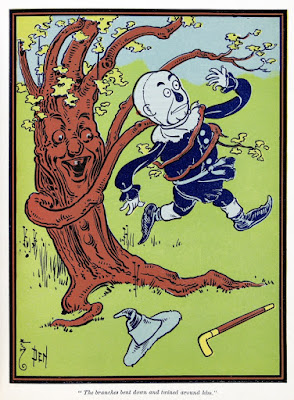If someone asks who came up with the The Wonderful Wizard of Oz, most people think of L. Frank Baum, but the illustrator William Wallace Denslow helped to create the characters and the world.
Denslow and Baum shared the copyright and royalties in the first Oz book. They also worked together on a 1902 stage production where Baum wrote the script and Denslow designed the characters.
Income from these ventures made Denslow rich enough to buy an island in the Bermudas and build a mansion in the style of a castle. He dubbed himself 'King Denslow I.'
But he and Baum had a falling-out over who created Oz, and Baum chose other illustrators for the later Oz books.
Denslow independently adapted the characters of Father Goose, the Scarecrow, and Tin Woodman for comic-strip adventures.
He tried to create his own separate world called "The Pearl and the Pumpkin" to rival Oz. He produced a book and an expensive Broadway stage version, but they weren't very successful.
After three failed marriages, a drinking habit, and financial setbacks, he was forced to sell his Bermuda mansion, and died relatively poor, having made and lost his fortune.

There's a facsimile copy of The Wonderful Wizard of Oz (Illustrated First Edition) with the Denslow illustrations.
William Wallace Denslow on Wikipedia
—








I read the article, but all of the Oz books I read as a child were illustrated by John R. Neill, and the Denslow illustrations just look “wrong” to me.
ReplyDeleteDenslow's outline and solid fill poster/serigraphic style of illustration has always appealed to me. I admire the work of the more recent successors in that tradition, like the ligne claire work of Hergé (creator of Tintin) and the WPA poster artists who came in-between.
ReplyDeleteI would like to know what medium Denslow used.
I’m not sure about all the details, but I believe Denslow only did the first book in the series, “The Wizard of Oz” published in 1899, in which he shares the copyright with Baum and gets illustration credits also (which may explain the castle and island in the Bermudas). John R. Neill’s Illustrations appeared first in the second book: “Ozma of Oz” published in 1907. Neill illustrated the next 10 books in the series (11 total), the last being “Glinda of Oz” published in 1920. Baum also re-released the first book in 1944 as “The New Wizard of Oz” with illustrations by Evelyn Copelman, (The text and introduction appear to be the same as the original version). Copelman did B&W illustrations (possibly scratch board?) which appear to me to be highly influenced by the movie, which was released in 1939; She also included several water-color illustrations.
ReplyDeleteFor a little fun, check out these U-Tube videos:
The Tornado Scene
https://www.youtube.com/watch?v=v0pKiMqBbsU
And
Dorothy meets the Scarecrow
https://www.youtube.com/watch?v=nYYMnfnN93Q
And
The Dark side of Oz
https://www.youtube.com/watch?v=NtExVJlgEC0
(Well I thought they were fun!) -RQ
some corrections and additions:
ReplyDeleteI have a later printing of the first book, (Bobbs-Merryll Co.) titled:
“The Wizard of Oz” which shows the original publishing date as 1899 (which was the date of the contract between Baum and Denslow for publishing, but the book wasn’t published until 1900.)
The first edition was titled “The Wonderful Wizard of Oz”, with later editions entitled “The Wizard of Oz’ and “The New Wizard of Oz”. Other titles considered before publishing were: “From Kansas to Fairyland”, “The City of the Great Oz”, “The Great Oz”, “The Fairyland of Oz”, “ The Land of Oz” and “A new Wonderland”.
Also, according to Mr. Wiki, Neill illustrated 13 sequels.
After Baum’s death in 1919 (“Glinda of Oz” apparently published posthumously) Baum's publishers delegated the creation of more sequels to Ruth Plumly Thompson who wrote 21, released every Christmas until 1942.
Also, other notable editions are… a 1986 Pennyroyal edition illustrated by Barry Moser, which was reprinted by the University of California Press; and the 2000 "The Annotated Wizard of Oz" edited by Michael Patrick Hearn.
That’s too bad. Clearly, at first, they had a good energy and sync. Sadly, greed has ruined many a good relationship.
ReplyDelete